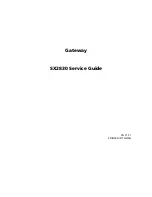
Version 6.6
329
MP-11x & MP-124
User's Manual
31. Software Upgrade
To load auxiliary files using an ini file:
1.
In the ini file, define the auxiliary files to be loaded to the device. You can also define
in the ini file whether the loaded files must be stored in the non-volatile memory so
that the TFTP process is not required every time the device boots up.
2.
Save the auxiliary files and the ini file in the same directory on your local PC.
3.
Invoke a BootP/TFTP session; the ini and associated auxiliary files are loaded to the
device.
31.1.1 Call Progress Tones File
The Call Progress Tones (CPT) and Distinctive Ringing auxiliary file is comprised of two
sections:
The first section contains the definitions of the Call Progress Tones (levels and
frequencies) that are detected / generated by the device.
The second section contains the characteristics of the Distinctive Ringing signals that
are generated by the device (see Distinctive Ringing on page
331
).
You can use one of the
supplied auxiliary files (.dat file format) or create your own file. To
create your own file, it's recommended to modify the supplied
usa_tone.ini
file (in any
standard text editor) to suit your specific requirements and then convert the modified
ini
file
into binary format, using AudioCodes DConvert utility. For a description on converting a
CPT
ini
file into a binary
dat
file, refer to the
DConvert Utility User's Guide
.
Note:
Only the
dat
file format can be loaded to the device.
You can create up to 32 different Call Progress Tones, each with frequency and format
attributes. The frequency attribute can be single or dual-frequency (in the range of 300 to
1980 Hz) or an Amplitude Modulated (AM). Up to 64 different frequencies are supported.
Only eight AM tones, in the range of 1 to 128 kHz, can be configured (the detection range
is limited to 1 to 50 kHz). Note that when a tone is composed of a single frequency, the
second frequency field must be set to zero.
The format attribute can be one of the following:
Continuous:
A steady non-interrupted sound (e.g., a dial tone). Only the 'First Signal
On time' should be specified. All other on and off periods must be set to zero. In this
case, the parameter specifies the detection period. For example, if it equals 300, the
tone is detected after 3 seconds (300 x 10 msec). The minimum detection time is 100
msec.
Cadence:
A repeating sequence of on and off sounds. Up to four different sets of
on/off periods can be specified.
Burst:
A single sound followed by silence. Only the 'First Signal On time' and 'First
Signal Off time' should be specified. All other on and off periods must be set to zero.
The burst tone is detected after the off time is completed.
You can specify several tones of the same type. These additional tones are used only for
tone detection. Generation of a specific tone conforms to the first definition of the specific
tone. For example, you can define an additional dial tone by appending the second dial
tone's definition lines to the first tone definition in the
ini
file. The device reports dial tone
detection if either of the two tones is detected.
The Call Progress Tones section of the
ini
file comprises the following segments:
[NUMBER OF CALL PROGRESS TONES]:
Contains the following key:
'Number of Call Progress Tones' defining the number of Call Progress Tones that are
Summary of Contents for MediaPack MP-112
Page 2: ......
Page 14: ...User s Manual 14 Document LTRT 65417 MP 11x MP 124 Reader s Notes ...
Page 21: ...Part I Getting Started with Initial Connectivity ...
Page 22: ......
Page 30: ...User s Manual 30 Document LTRT 65417 MP 11x MP 124 Reader s Notes ...
Page 31: ...Part II Management Tools ...
Page 32: ......
Page 34: ...User s Manual 34 Document LTRT 65417 MP 11x MP 124 Reader s Notes ...
Page 78: ...User s Manual 78 Document LTRT 65417 MP 11x MP 124 Reader s Notes ...
Page 84: ...User s Manual 84 Document LTRT 65417 MP 11x MP 124 Reader s Notes ...
Page 86: ...User s Manual 86 Document LTRT 65417 MP 11x MP 124 Reader s Notes ...
Page 91: ...Part III General System Settings ...
Page 92: ......
Page 102: ...User s Manual 102 Document LTRT 65417 MP 11x MP 124 Reader s Notes ...
Page 103: ...Part IV General VoIP Configuration ...
Page 104: ......
Page 162: ...User s Manual 162 Document LTRT 65417 MP 11x MP 124 Reader s Notes ...
Page 172: ...User s Manual 172 Document LTRT 65417 MP 11x MP 124 Reader s Notes ...
Page 199: ...Part V Gateway Application ...
Page 200: ......
Page 202: ...User s Manual 202 Document LTRT 65417 MP 11x MP 124 Reader s Notes ...
Page 240: ...User s Manual 240 Document LTRT 65417 MP 11x MP 124 Reader s Notes ...
Page 286: ...User s Manual 286 Document LTRT 65417 MP 11x MP 124 Reader s Notes ...
Page 287: ...Part VI Stand Alone Survivability Application ...
Page 288: ......
Page 296: ...User s Manual 296 Document LTRT 65417 MP 11x MP 124 Reader s Notes ...
Page 319: ...Part VII Maintenance ...
Page 320: ......
Page 326: ...User s Manual 326 Document LTRT 65417 MP 11x MP 124 Reader s Notes ...
Page 347: ...Part VIII Status Performance Monitoring and Reporting ...
Page 348: ......
Page 377: ...Part IX Diagnostics ...
Page 378: ......
Page 390: ...User s Manual 390 Document LTRT 65417 MP 11x MP 124 ...
Page 392: ...User s Manual 392 Document LTRT 65417 MP 11x MP 124 Reader s Notes ...
Page 403: ...Part X Appendix ...
Page 404: ......
Page 618: ...User s Manual 618 Document LTRT 65417 MP 11x MP 124 Reader s Notes ...
















































